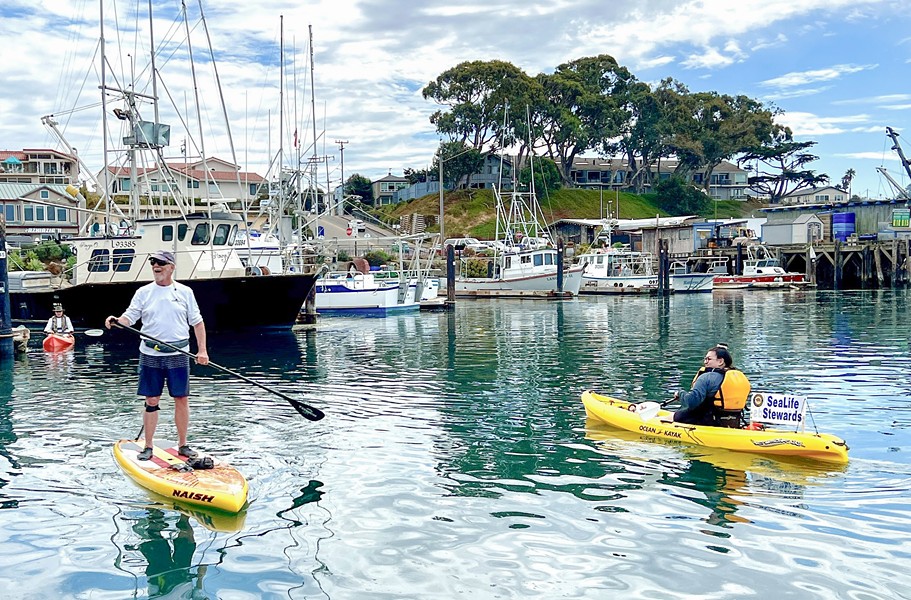The waters of Morro Bay are doubling as a vast classroom for kayakers, stand-up paddle boarders, boaters, and surfers for the ninth year this summer.
From the end of May through October, 22 volunteers of the SeaLife Stewards program launch kayaks from the marina behind Bayside Café and from Coleman Beach between the stacks and Morro Rock. The stewards become guides to recreating visitors, teaching them how to enjoy the bay while safely navigating its rich wildlife.
Take it from Atascadero resident Kelley Meece, a retired school counselor who dreamed of being a marine biologist when she was young. She enrolled as a SeaLife Steward roughly four years ago, and her love for the program inspired her sister to consider joining.
“I wanted to learn more about the bay, but I also wanted to help people have a good experience without hurting any wildlife,” she said. “The otters need rest, too, and people want to see an otter. They want to get up close to them, but you’re supposed to stay five kayak lengths away, and I didn’t even know that the first time out.”
Funded by California State Parks, the SeaLife Stewards program models itself after an existing Monterey Bay National Marine Sanctuary program called Team Ocean Conservation Education Action Network or Team OCEAN.
Most Fridays, Saturdays, and Sundays, stewards kayak or paddleboard out to the bay with a mandatory volunteering partner in tow. From 10 a.m. to 2 p.m.—usually when kayak shops open and more people enjoy the water—they monitor other visitors and serve as naturalists for them to talk to.
California State Parks Interpreter Robin Hazard said that SeaLife Stewards never go out alone, and their pairings are tracked by a software that volunteers use to sign up for shifts.
“Something that they always do at the beginning of a shift is a briefing beforehand,” Hazard said. “They talk about the weather for the day, how the wind is looking, which direction the tide is going. They want to be responsible and not get stuck … they can always cut shifts short.”
Hazard added that SeaLife Stewards serve a similar purpose on the water as park rangers, interpreters, and naturalists do on a trail.
“Instead of pulling up their phone later on and looking it up, they can turn to them,” she said. “Our partners really rely on this program as well.”
The Morro Bay Harbor Department is a partner of the SeaLife Stewards program. In 2020, the volunteer program temporarily stopped because of the pandemic. But increased activity in the area prompted the Harbor Department to request bringing back the program the same year, albeit with an unusual new season schedule that ran from October to December.
“Around September, the harbor noticed that there was a lot of disturbance out in the bay,” she said. “They noticed that there was more visitation in general; everybody was often outside during the pandemic.”
For seasoned volunteer Gary Messerotes, who has eight years of SeaLife Stewards experience, every annual training session equips him with new information about animal behaviors and regulation.
He’s a shoo-in for the stewardship role. Before arriving in San Luis Obispo County, Messerotes led bike tours as a State Parks docent on Angel Island in the San Francisco Bay. He also currently volunteers at the Marine Mammal Center. The SeaLife Stewards program is his favorite, because it involves nature and animals.
“We’ve got a whole group of water birds out here, we’ve got sea lions, we’ve got harbor seals,” Messerotes said. “This is a unique system right in this little estuary we have here because we have such a wealth of marine life and bird life. That’s not even talking about what’s under the water.”

- PHOTO BY JAYSON MELLOM
- LONGTIME LOYALISTS SeaLife Stewards volunteers Gary Messerotes and Kelley Meece and California State Parks Interpreter Robin Hazard stand with one of the program’s kayaks stored in the shed by the marina launch location.
Stewards frequently impart otter education and good boating practices to visitors on the water. The sea otter is a keystone species, meaning its survival is vital for the ecosystem. Otters eat 25 percent of their body weight in food every day to keep up with high energy demand. They spend a large portion of their time resting to conserve energy for eating, grooming, and taking care of pups.
“When a kayaker kayaks into a group of otters that are resting and quietly laying on their back, [otters] have to expend a tremendous amount of energy … to get away that they would normally use for eating or taking care of their pup,” Messerotes said.
Serving as a SeaLife Steward since 2017, Messerotes noticed a major misconception about program volunteers over the years.
“The people think we’re here to be the otter cops,” he said. “At times, when we paddle towards them, we see them shying away and paddling faster to get away from us. At that point, we kind of back off.”
While the stewards aren’t law enforcement, they’re allowed to report major disturbances and incidents of harassment. Each volunteer receives a radio device to inform Harbor Patrol.
“Once in eight years, I’ve had to call Harbor Patrol for a couple who had a small dog on their kayak. They were too close to the otters and the dog was barking at the otters and caused the otters to [get away],” Messerotes said. “I talked to them … the guy cut me short and paddled off. I backed off and within five minutes they started doing the same thing again.”
The crux of volunteers’ roles as stewards is data collection and observation, according to Messerotes. They carry dive slates when they go out on shifts to pencil in data on the wildlife people run into, the number of animals, the location, and the level of disturbance. At the end of the shift, volunteers send pictures of their dive slates to officials who input the observations into a larger database.
“All the data I’m collecting from them throughout the summer all goes into the annual report, and I can share that with our partners,” State Parks’ Hazard said.
She encouraged those who are interested in becoming a steward to email [email protected] in January when she starts the recruitment process. New and old recruits alike receive training each year prior to the stewardship season.
Don’t want to consistently serve on the water? There’s a land shift option for those who are healing from injuries or if it’s a particularly windy day. These volunteers man a section by Coleman Beach that entices visitors with an “Ask us about wildlife” A-frame sign and offers informational booklets.
But liking the water, being a people person, and loving animals boost chances of being an ideal volunteer, according to Hazard and volunteers Messerotes and Meece.
“Sometimes, it’s good to know all the local stuff too, like, ‘Where’s the best taco?’” Meece said with a laugh.



Comments